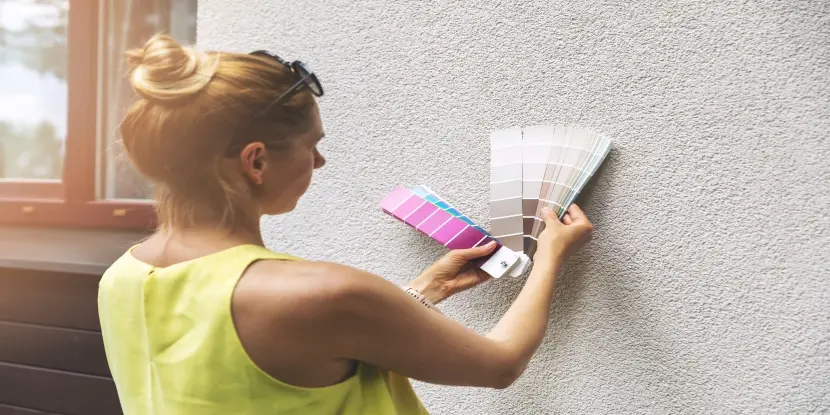
Five Star Painting outlines key factors for choosing exterior paint.
|
Believe it or not, exterior paint color DOES matter. Did you know that the right exterior house paint color can potentially net you thousands of dollars more when you sell your home? Needless to say, with so many different paint colors and options available, it can be overwhelming to decide on a few specific colors. Below, you’ll get some insider tips on how to select the best exterior paint colors for your home’s exterior. Use these tips to give yourself the confidence to choose great exterior paint for your home, without second-guessing your choice.
Use Actual Paint Samples (Not Printed Ones)
Printed paint samples are great for providing a general idea of what the paint color may look like once it’s dried. However, looks can be deceiving. Especially when printed paint swatches are viewed indoors, under artificial lights. When choosing your exterior paint colors, it’s best to use real paint samples instead of relying on a printed version. Plus, you never know how a particular paint will look over different base materials. For example, painting a wood surface versus painting exterior brick or stucco could alter how the color appears.
There are certain types of wood and other materials that absorb paint in ways that can drastically change its appearance once it dries. You should also keep in mind how much exposure to direct sunlight can change the appearance of an exterior paint color. Over time, extended exposure to the sun will make the color appear much lighter. If your home receives a lot of direct sunlight throughout the day, it’s better to select a color that’s a shade or two darker than your original choice.
The best way to tell how a color will look on the exterior of your home is to purchase a small test size of the paint colors you’re considering. Use your test paint on a small area of your home’s exterior (choose an area that’s not highly visible). Swatch paint on both the north and south sides of your house. Always paint in the areas where the lighting and conditions can vary. Remember to place your paint sample next to your desired trim color to get an idea of how they may look side by side. And finally, if you truly want to get the best idea of what your home will look in all conditions, once it has dried, check your paint samples at different times of the day.
Factor in Neighboring House Colors
Want to score points with potential home buyers and your neighbors? Consider choosing colors that will complement the curb appeal of the entire neighborhood. If your neighborhood has an HOA, check to ensure you’re within your community's guidelines for approved exterior paint colors. You may have to consult with your local community board before making a final decision on color. Consider choosing colors that set your house apart, but that don’t clash or compete with neighboring homes. To maintain neighborhood appeal, choose colors that compliment, but don’t mirror your neighbors' homes. Similar colors are okay, but choosing colors that are exactly the same can detract from the uniqueness of your home.
Observe Different Light
As mentioned, sunlight can play a large role in the exterior paint color you choose. How will the colors you choose look in direct sunlight versus a cloudy day? If it looks great under one condition but not the other, you may want to start looking at some other color options that appear more consistent under different conditions. You should also consider which direction the front of your home faces. If your home is more north-facing, it won’t get as much direct light throughout the day—making the color appear cooler. If you’re home is south-facing, your colors will look a lot warmer—making them feel less intense and more muted.
Remember Trim
To trim or not to trim? Well...that shouldn’t even be a question! Painting the trim around your home should be a part of every exterior paint job. Not only can painting the trim and accent protect the wood facia around your home from weather and potential rot, but it also provides a much-needed color contrast to your homes’ exterior. If you want to create a subtler contrast, try choosing an exterior trim color that’s a few shades lighter or darker than the exterior color. Selecting a trim color in the same color category as your main color helps highlight your home without creating a drastic color contrast. If you prefer to make a bolder statement with your trim, choose a color that is more of a contrast from the main exterior color. Either way, don’t overlook the importance of selecting a good trim color to compliment the rest of your new house look.
Related Topic:Exterior Trim Painting
Consider Deck and Fence Color
Curb appeal doesn’t end at the curb. The color of your deck and fence (if you have one) should also coordinate with the exterior paint color you choose. Although some homeowners tend to overlook this detail the good news is you have a lot of flexibility and options when it comes to deck and fence colors. Depending on the type of material used to build your deck or fence you can choose either a paint or stain. Both choices offer a wide variety of color options. Even concrete decks can be painted or stained.
One thing to consider when deciding which color paint or stain to use on your fence and/or deck is the age and material it’s made of. Older decks or fences made of wood may require a primer coat prior to painting to reduce the amount of paint absorbed by the wood. It’s also a good idea to use the same color test method you applied on the exterior of your house and trim on your deck and/or fence too.
Related Topic:Deck Staining & Fence Staining Services
What About Your Garage?
Another section of your home that might get overlooked when choosing exterior paint colors is the garage. Do you want your garage door to be the same color as the rest of your house, or do you prefer a contrasting color that really makes it stand out? There’s no wrong or right answer. It really comes down to a matter of preference. However, just like with a deck or fence, take into consideration the condition and type of material that will be painted. Vinyl, wood, or metal garage doors will require different types of prep work to properly prepare the material for painting. Wood doors may have to be scraped and primed prior to painting, whereas vinyl or metal doors may only require a good cleaning. Either way, making sure the surface is properly prepared will ensure whatever color you choose will last a long time.
Do You Have a Shed?
If you have a shed, it’s tempting to just slap on any color of paint and call it a day. But your shed is a part of your property and it should complement the rest of your home. Before choosing a type and color, it’s important to know there are different paint options for different types of shed material. For example, a metal shed will look and hold paint better if a rust-inhibiting primer is used prior to painting. After the primer, using 100 percent latex paint can help protect your shed from the elements and make it look like new. For sheds made using wood siding, a waterproof primer prior to painting can help preserve the wood and keep it from rotting prematurely, which can help it last a little longer.
Related Topic:Shed Painting Services
Get Professional Advice
Given all the available color options, choosing a good exterior paint color for your home can get a little overwhelming. Choosing the wrong color for the exterior of your home can be a costly mistake that leads to wasted time and unnecessary headaches. But if you follow these tips, you’ll be able to make a more informed decision about how to choose a color that’s perfect for your home. If you’re still not sure, or you need some suggestions, the pros at Five Star Painting can help. We’re experts when it comes to choosing just the right paint color for your home, garage, deck, fence, shed, or anything else you need to be painted. If you want to take the stress and worry out of deciding what exterior paint color is best for your home, contact Five Star Painting today!


